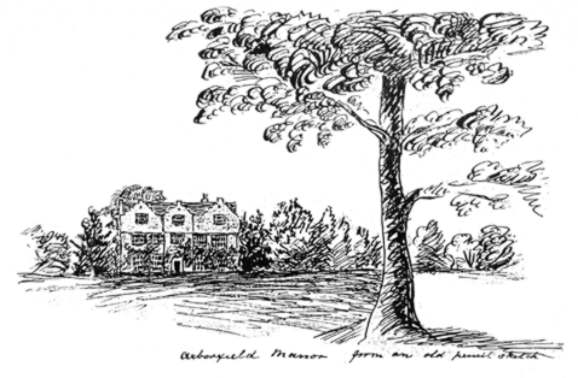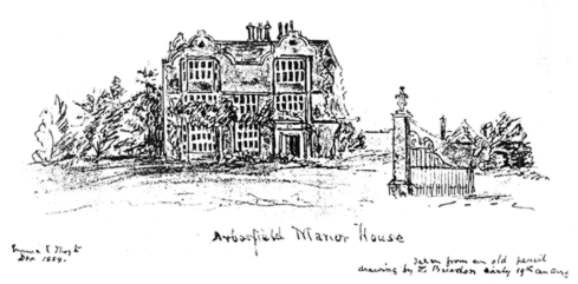
|
Arborfield
|
|
Properties
Related sites:
The
|
Whether the 'Manor of Arborfield' is a property or a title is a moot point, but this article on the 'Lords of the Manor' is included here. Two sketches of the old Manor House survive from a contribution to the Berkshire Local History Club in 1889 by Emma Elizabeth Thoyts, who later became the wife of John Hautenville Cope; they are shown here. The first shows what appears to be the front elevation:
The second shows what might have been the side elevation, probably looking from the left when compared with this view. The building was partly demolished when the original sketch was drawn:
The captions are: "Arborfield Manor House; Emma E. Thoyts, Dec. 1889; Taken from a pencil drawing by J. Breedon, early 19th Century". THE LORDS OF THE MANOR OF ARBORFIELD The Manor of Arborfield was not mentioned by name in the Domesday Survey which was completed in 1086 and at this time formed part of the Manor of Sonning, held by the Bishop of Salisbury. The earliest mentioned “lord of the manor” seems to have been a powerful Abbot called “Elsi” of the “Old Minster” (the Cathedral Church) of Winchester. He held four manors and two estates, of which Burghfield and Edburgefeld (Arborfield), dependent on Sonning, were two. These he leased out, but there is no record to whom. Abbot Elsi was at the “ Old Minster” in the reign of Edward the Confessor (1042-1066) and was outlawed in 1070, after the Norman Conquest. This indicates that the Manor of Arborfield is likely to be Saxon. It consisted, as other manors did, of a castle or fortified house standing in the “lords’ Demesne” (the Park lands); a church with the churchyard round it, and nearby, a little house for use as a Rectory. All these would generally be built close to a river (as in Arborfield), so that there should always be a supply of fish on Fridays and fast days. Along the river would be meadow lands. The peasants’ cottages would be built close together and near crossroads, each with a bit of ground surrounded by a fence. On the river, a mill belonging to the lord would be built. Sometimes the manors were owned by a bishop, as in the case of Arborfield, or an abbey where the dues had to be paid to them. The next “lord of the manor” mentioned after Abbot Elsi was “Osmund Bullock of Edburghfeld”. He also paid tithes (a tithe was a tax of one tenth of the annual produce of land or labour for the support of the Church and clergy) to the great monastery at Abingdon for some of his lands in Arborfield. The Bullock family were distinguished and later held high positions in the county. In 1250 Gilbert Bullock, a descendant of Osmund, made this declaration: “That all lands held by him in the Manor of Sunninge was held subject to the Goodwill of the Bishop of Salisbury” he bound himself and his heirs “to deliver it up to the Bishop or his successors whenever called upon to do so.” This Gilbert Bullock was made Kings’ Reeve in 1275 (i.e. a Trustee or Baliff of the Crown Lands). By 1589, Thomas Bullock found it necessary to sell the manors of Arborfield and Barkham to Edmund Standen, who was a Clerk of the Petty Bag of the Court of Chancery. This sale was contested by the Bullock family, (see Arborfield and Barkham Manors in Contention 1589-1662 by David French). Edmund Standen died in March 1603, the year the Jacobean manor was built, to be succeeded by his son William. In 1615 Sir William was Sheriff of the County of Berkshire; he died in 1639. THE MANOR AND ITS GENEALOGY The manor of Arborfield is a manor within a manor, lying within that of Sonning, and belonged formerly to the Bullocks, an ancient family of this place:- several of whom served the office of Sheriff in the 14th - 16th centuries:- one of them is called in their pedigree “Hugh with Brazen Head”. From this family, the manor passed into the possession
of the family of Standen, who created early in the 17th century a noble
mansion of Jacobean stature, on the former site of a more ancient house.
William Standen of Arborfield, Lord of the Manor of Arborfield, Barkham
etc., was Sheriff of Berkshire in 1615. He died 18th May 1639; one of
those large table monuments, so common in the 16th and 17th centuries
was erected in his memory in the chapel belonging to the family in the
parish church. This monument remains to this day, (in our present
church). In the year 1837, Dawson pulled the old house entirely
down, preserving with considerable taste, the Boat House, commemorated
in the pages of Mary Mitford's “Our Village”, and nearly upon its site
erected a smaller residence of the same style and architecture. MANORIAL RIGHTS 1788 Of the manor of Arborfield with 25 messuages, 3
mills; 2 dove houses; 3 kilns; 50 gardens; 500 acres of land: 200 acres
of furze and heath, common and pasture for all manner of cattle, common
turbary and separate fishing in the river Loddon; free warren; fairs,
markets tolls, Court Leet, Court Baron, and view of Frankpledge
belongeth: waifs, strays, deodands, goods and chattels of felons and
fugitives, with the appurtenances in Arborfield, Newland, Hurst and
Shinfield.
|
||
|
Any Feedback or comments on this website? Please e-mail the webmaster |

